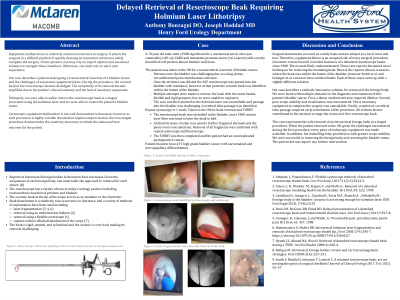Urological Surgery
Delayed Retrieval of Resectoscope Beak Requiring Holmium Laser Fragmentation

Has Audio
Introduction/Purpose: Equipment malfunction is a common occurrence in surgery. It places the surgeon in a difficult position having to devise an innovative solution to safely complete the surgery. If time permits, one may rely on expert opinion to navigate these situations. We present a case of equipment failure in a patient undergoing a bladder tumor resection.
Methods or Case Description: 78-year-old male with a history of CRPC. He had a cystoscopy done in the office, which revealed a tumor on the lateral wall of the bladder. The patient was taken to the OR for a TURBT. Entrance into the bladder with the resectoscope was difficult secondary to a peno-membranous stricture. Once in the bladder, the ceramic beak of the scope detached and was seen in the lumen. Multiple attempts were made to remove the beak with the equipment at hand, however we were unsuccessful and the procedure was aborted.
The patient was brought back to the OR for a 2nd attempt to retrieve the beak and complete the TURBT. Once the resectoscope beak was identified in the bladder, a 1000 micron laser fiber was used to laser the beak in half. Removal of all fragments was confirmed with repeat cystoscopy and fluoroscopy. The TURBT was then completed and the patient had an uncomplicated postoperative course.
Outcomes: We were able to safely remove the resectoscope beak in a staged procedure using the holmium laser and we were able to resect the patient’s bladder tumor.
Conclusion: Equipment malfunction is well documented in literature, however as each procedure is highly variable the solution requires improvisation. Our two-staged procedure demonstrates the creativity necessary to obtain the safest and best outcome for the patient.
Methods or Case Description: 78-year-old male with a history of CRPC. He had a cystoscopy done in the office, which revealed a tumor on the lateral wall of the bladder. The patient was taken to the OR for a TURBT. Entrance into the bladder with the resectoscope was difficult secondary to a peno-membranous stricture. Once in the bladder, the ceramic beak of the scope detached and was seen in the lumen. Multiple attempts were made to remove the beak with the equipment at hand, however we were unsuccessful and the procedure was aborted.
The patient was brought back to the OR for a 2nd attempt to retrieve the beak and complete the TURBT. Once the resectoscope beak was identified in the bladder, a 1000 micron laser fiber was used to laser the beak in half. Removal of all fragments was confirmed with repeat cystoscopy and fluoroscopy. The TURBT was then completed and the patient had an uncomplicated postoperative course.
Outcomes: We were able to safely remove the resectoscope beak in a staged procedure using the holmium laser and we were able to resect the patient’s bladder tumor.
Conclusion: Equipment malfunction is well documented in literature, however as each procedure is highly variable the solution requires improvisation. Our two-staged procedure demonstrates the creativity necessary to obtain the safest and best outcome for the patient.

Anthony F. Bonzagni, DO
urology resident
McLaren Macomb
Berkley, MI, US
